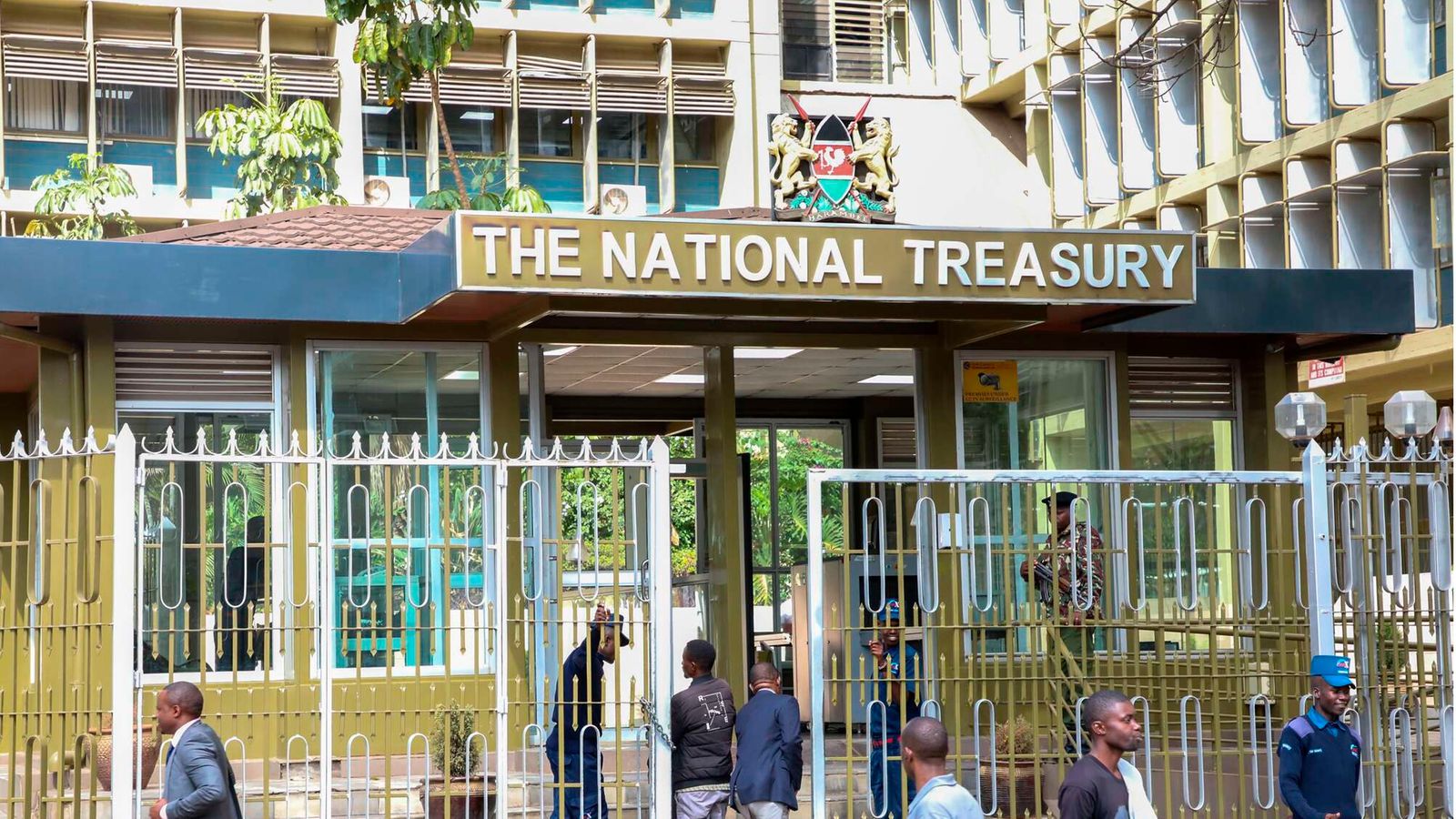- Kenya’s rising debt obligations have failed to cut back the debt that at present stands at about $82.2 billion.
- Service prices went up from 58% after the federal government paid $2 billion Eurobond.
- Sovereign bond-holders accounted for $6.6 billion of the exterior public debt inventory.
The Nationwide Treasury has laid naked the ache awaiting Kenyans in repaying loans borrowed from exterior lenders and domestically. Contemporary information tabled in Parliament reveals that taxpayers will dig deeper of their pockets within the subsequent monetary years to repay mortgage obligations.
Particulars present that for each $0.78) Sh100 the federal government collects, $0.53 (Sh68) goes to servicing the $82.2 billion (Sh10.6 trillion) debt pile reported as of June 30, 2024. The treasury revealed that the nation’s debt inventory elevated by $2.3 billion (Sh303 billion) in contrast within the yr ended June 2024 in comparison with a yr ealier. At present, Kenya’s debt inventory is projected to hit $100.7 billion (Sh13 trillion) by June 2028.
It stated the service prices went up from 58 per cent final yr after the federal government paid $2 billion (Sh259 billion) Eurobond. It has additionally emerged that taxpayers forked about $12.4 million (Sh1.6 billion) as dedication charges for loans it had borrowed but was not prepared to make use of.
Final yr, taxpayers paid about $10.8 million (Sh1.4 billion) for loans taken however not disbursed to the respective companies that ought to utilise the borrowings. Regardless of the assurances by Treasury that the debt scenario would enhance, the 2024 public debt report reveals it could value as a lot as $17.8 billion (Sh2.3 trillion) to service debt.
Curiosity funds alone are projected to value properly above $7.7 billion (Sh1 trillion) within the subsequent three monetary years.
“Over the medium time period, home curiosity funds as a share of GDP ($124 billion or Sh16 trillion) is projected to stay above three per cent whereas exterior curiosity funds are projected at about one per cent,” the report reads.
“In nominal phrases, whole curiosity fee is projected to extend to $8.4 billion (Sh1.079 trillion) within the monetary yr 2027-28 from $6.5 billion (Sh840 billion) within the FY 2023-24 majorly pushed by home curiosity funds,” Treasury stated.
Learn additionally: Visualising the state of debt in Africa 2024
Kenya’s rising debt obligations
The projected enhance in repayments signifies that Kenyans is not going to take pleasure in simply but, if the current downgrade by credit score corporations is something to go by. The nation continues to be looking at a fundraising nightmare from the worldwide markets after world credit score rankings company Fitch, downgraded Kenya’s sovereign score to “B-” from “B”.
Scores large Moodys had additionally moved from B3 score, whereby the nation’s debt obligations are speculative and topic to excessive credit score danger, to Caa1 score, whereby the obligations are poor and topic to ‘very excessive credit score danger.’ Moody’s attributed the downgrade to Kenya’s incapacity to impact fiscal consolidation measures that might decrease the chance of defaulting.
The downgrades put Kenya at a heightened danger of dropping the attractiveness of the worldwide lenders after the federal government backtracked on key income measures following protests that gripped the nation in June and July.
However in response to the debt evaluation report, World Financial institution stays the nation’s prime lender with recent Nationwide Treasury particulars exhibiting its dimension has expanded to about $12.4 billion (Sh1.6 trillion). The newest information from the Treasury reveals that World Financial institution’s share accounted for 30 per cent whereas Worldwide Sovereign Bond (ISB) holders and China have been among the many main exterior collectors.
Sovereign bond holders accounted for $6.6 billion (Sh854 billion) of the exterior public debt inventory whereas China’s lending stood at $5.7 billion (Sh737 billion) as of June 30, 2024. The small print might forged mild on how Kenya has been attracting extra billions from the West since President William Ruto assumed workplace.
The info reveals that taxpayers owed Africa Growth Financial institution $3.9 billion (Sh508 billion) and $3.3 billion (Sh421 billion) to the Worldwide Financial Fund (IMF). Japan and France emerged because the bilateral lenders with excessive quantities at $1.1 billion (Sh142 billion) and $744 million (Sh96 billion) respectively as of June 30, 2024.
United States, which President Ruto has toured greater than 4 instances since taking up, has lent Kenya a complete of $310 million (Sh40 billion). Treasury revealed that Italy, which can be pursuing dam contracts within the nation, lent the nation $248 million (Sh32 billion).

Regionally, industrial banks are owed the very best quantity at $18 billion (Sh2.36 trillion), adopted by belief and pension funds at $12 billion (Sh1.55 trillion) out of the $41.8 billion (Sh5.4 trillion). The federal government had borrowed $1.3 billion (Sh170 billion) from Central Financial institution of Kenya, $2.9 billion (Sh379 billion) from insurance coverage corporations, and $7.3 billion (Sh943 billion) from ‘different buyers’.
The report signed by Treasury Cupboard Secretary John Mbadi states that the share of debt to the nation’s wealth would decline. “Whole public debt as a share of GDP is projected to say no within the medium time period. Within the monetary yr 2027-28, whole debt to GDP is projected to say no to 53.7 per cent from 65 per cent in 2023-24,” the assertion reads.
The federal government, throughout the yr below evaluate, contracted 36 new exterior loans of $6.95 billion (Sh897 billion), largely from multilateral lenders, dashing hopes for any reprieve. A number of parastatals additionally borrowed $604.6 million (Sh78 billion) which isn’t assured by the Nationwide Treasury.
Amongst them are loans borrowed by Kenya Energy ($170.5 million), KenGen ($77.5 million), Kenya Ports Authority ($48.8 million), KAA ($77.5 million), Nationwide Oil Company ($77.5 million), NCPB ($31 million), New KCC ($11.6 million), JKUAT ($17.8 million) amongst others.
The federal government, it has emerged, has lent about $9.3 billion (Sh1.2 trillion) to varied state companies, a few of which have challenges making repayments. Arrears from the loans amounted to $2 billion (Sh266 billion), of which $1.3 billion (Sh167.5 billion) associated to Kenya Railways Company SGR undertaking “which is but to be serviced”.
SGR arrears accounted for 62 per cent of the overall arrears, whereas the water sector had Sh34 billion unpaid as water corporations aren’t remitting funds to water companies. However, the Treasury says there isn’t any trigger for alarm, citing looming reforms within the administration of public debt.
Treasury stated the general public debt workplace has ready sinking fund rules, whose approval would guarantee money is out there to fulfill debt obligations. Kenya can be looking for to diversify borrowing sources saying it could float extra versatile and cost-effective financing options.

That is after the federal government borrowed 73 per cent of its deficit from the native market regardless of an elevated menace of crowding out native debtors.
The federal government had by the 2023 Medium-Time period Debt Administration Technique (MTDS) introduced a suggestion on the way it was going to finance, its borrowing which was to comprise 50 per cent from the native market and 50 per cent exterior borrowing.
Learn additionally: Kenya’s Parastatal Set for Privatisation Declared Bancrupt Over $71m Debt
Borrowing deviated from set plan
Nonetheless, precise borrowing prior to now one yr deviated from the plan, with 73 per cent sourced domestically and solely 27 per cent externally, as an alternative of the focused 50:50 break up. “The precise internet home financing to exterior financing was 73:27, deviating from the optimum technique. The deviation was partly on account of restricted entry to exterior financing,” the report by treasury reads partly.
Elevated native borrowing by the federal government and excessive curiosity noticed, loans by industrial banks fall by $1.2 billion (Sh158.2 billion) within the first six months of 2024, in response to disclosures by the Central Financial institution of Kenya (CBK).
[1 Kenyan Shilling (Sh) equals 0.0078 US Dollar]